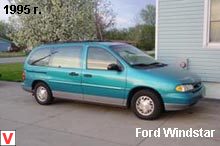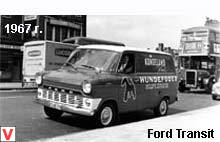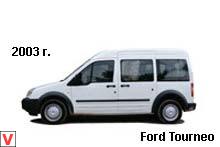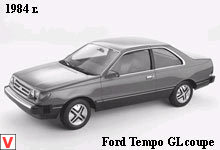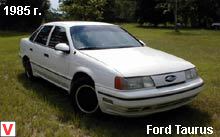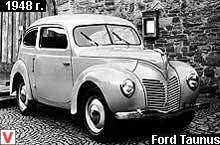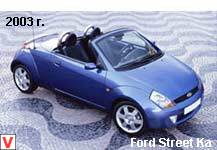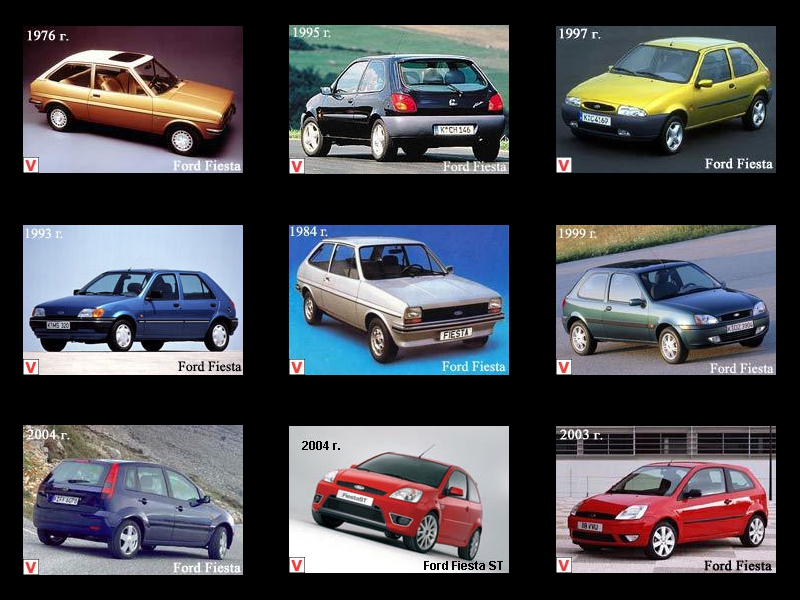
On December 3, 1973, Henry Ford and the board of directors of Ford Motor Company made a historic decision to launch a project called Bobcat. Bobcat was just a codename. For a long time, the company did not dare to announce the real name, which led to a lot of guesswork and assumptions about the new model in the press. In the end, in 1975, at a press conference in Detroit, Henry Ford II announced the real name of the model - Fiesta. Production of the new car was launched at the two largest plants - in Cologne (Germany) and Danton (England). The Ford Fiesta compact 3-door and 5-door hatchback family has been in production since 1976.
The 1.0-liter 40-horsepower engine became the basic power unit for this model, but it was also more powerful, at that time, the Ghia version with a 53-horsepower 1.1-liter engine capable of a maximum speed of 147 km / h. The engine is quite compact, stands across the compartment. The radiator is located classically - in front, and to ensure thermal conditions at low speeds, it is equipped with an electric fan, which switches on automatically, with a thermal sensor on the thermostat housing. The generator stands on top of the side of the engine (front in the direction of travel), driven by a V-belt.
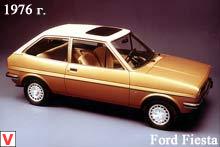
MacPherson suspension in front, lower arms with ball bearings, the upper part of the shock absorber rests on rubber-metal blocks in the supporting cups of the body. By the way, the body of the Fiesta of the first generation attracts attention by the fact that in its manufacture steel of various thickness is used - thicker on bearing parts, thinner on body panels. The cabin was considered one of the most comfortable and spacious in class B.
The rear seat back is removable, which allows you to get, if necessary, a fairly large cargo bay. The mechanical drive of the clutch is also equipped with an automatic compensation of cable stretching and setting the optimum idling pedal. All pedals (brakes, clutches, gas) of the suspended type, of identical design, are located quite comfortably. The ignition system is simple, contact - with a classic interrupter and distributor. The carburetor is also very simple, single-chamber, mechanically driven start-up dresser. For the most part, controls are focused on the steering wheel: turn indicators, light and wiper switches.

Electric glass washer. The heating system, in spite of its simplicity, is quite effective, it has many adjustable deflectors in front, which allow blowing the windshield and side windows in the area of the mirrors. Rear window has a built-in electrical heating. Dual-brake system, rear drum brakes are equipped with an automatic pad wear compensation. The “fiesta” of the first generation is characterized by: big-bellied sides, a square nose and rounded openings. In 1983, the Fiesta I underwent the first significant modernization, which led to the emergence of a second generation. Most changes affected the front of the car, which has become smoother, lighting, as well as the interior.
The three-door Fiesta II was offered in several trim levels, ranging from the simplest Fiesta C to the exquisite and richly equipped Fiesta Ghia. A cargo version of the Fiesta Kasten was also produced. Petrol engines of the Kent and CVH families with volumes ranging from 1.0 to 1.4 liters (from 45 to 75 hp) were installed on the vehicle. The 1.6-liter (95 hp) engine was installed on the Fiesta XR2 sports version. In addition, the second generation Fiesta was equipped with a 1.6-liter diesel engine (54 hp). Since 1985, some modifications began to install an automatic transmission, and in 1986, an injection engine of 1.4 liters appeared.
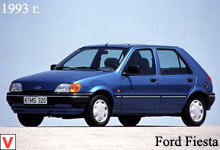
The car has acquired special features and began to look more dynamic. The last Ford Fiesta of the second generation was released in 1989 - a total of almost 2 million cars were produced between 1983 and 1989. The story of the third generation begins with the modernization in 1989. Fiesta received a larger body and updated mechanics. Now the car was produced not only in the three-door, but also in the five-door version. The third-generation Fiesta were the first small cars with four-channel electronic ABS, an emergency braking system and a traction effort distribution system.
In addition to the hatchback, the Fiesta Kasten cargo version was produced, and in 1991 the Fiesta Courier van was introduced. The XR2i modification and supersports RS Turbo were introduced in 1990 and 1992, they were joined by a powerful version of the Fiesta RS1800 with an 1.8 16V engine with a power of 130 hp. At the end of 1995, the Ford model range was replenished with a completely new Fiesta, equipped with a series of new Zetec SE engines (75 hp in the 1.25-liter version and 90 hp in the 1.4-liter version). The 1.3-liter gasoline engine version (60 hp) was renamed Endura-E, and the 1.8-liter Endura-D diesel engine, 60 hp, completed the line.
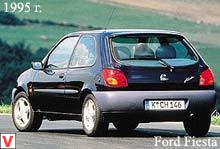
The third generation Fiesta was discontinued at the end of 1996, when it was replaced by the Fiesta IV. In August 1995, the fourth generation was introduced. Fiesta IV was produced in the form of a three-and five-door hatchback. Since 1996, began to produce the next generation Fiesta Courier, and since 1998 - the next generation of cargo modification - Fiesta Kasten.
In the interior decoration appeared more expensive materials. Installed gasoline engines of the Endura family with a volume of 1.3 liters (50 and 60 hp) and new engines of the Zetec SE family with a volume of 1.25 to 1.4 liters (75 to 90 hp), as well as a diesel engine volume of 1.8 liters (60 and 75 hp with direct injection). The most powerful modification in 2000 was the Fiesta IV Sport with a 16-valve 1.6-liter engine (103 hp) - the car accelerated to 100 km / h in 10 seconds. The sports version had 15-inch cast wheels, it was also distinguished by more “short” gears and a stiffer suspension.
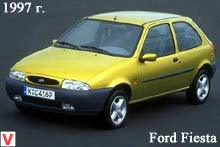
At the Frankfurt Auto Show in 1999, Ford introduced the updated “Fiesta”, which received new family features, namely, New Edge-style headlights, a different form of bumper and false radiator grille. In 2002, the fifth generation Fiesta debuted at the Frankfurt auto show. The new model has received advanced equipment. When it was developed, the creators of Ford primarily focused on aspects such as space, style, safety and quality control. Compared to the previous generation, the Fiesta V is larger, heavier and has a larger wheelbase. Due to the increase in size, the designers managed to make the rear seats more comfortable, and the car, in general, more stable.
The body design is nothing like the previous generation Fiesta. The salon is quite cozy. The seats are upholstered and comfortable enough. Adjusting them is very simple: moving the front and back and forth is done with a large bracket. The back of the front seat cushion, if desired, can be raised and lowered with a special plastic lever. The inclination of the backrest is regulated by a convenient wheel, the end of which is prudently equipped with a rubber band so that your fingers do not slip. The rear seat folds in whole or in parts. In this case, the luggage compartment is increased by more than three times.
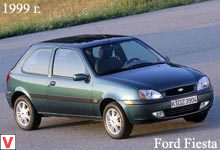
Not only the devices have a backlight, but all the buttons down to the side window power windows buttons. Comfortable steering wheel, sheathed in natural leather, has a sensitive and informative power steering. The body is a sturdy box with rigid all-stamped sidewalls and an almost vertical rear wall that increases the luggage compartment volume compared to the old Fiesta, which had a rear part sloping. The doors have additional side impact protection, and their rigid window frames do not limit the view. The fifth door can be opened with a special button located on the left side of the instrument panel. All glasses have an unobtrusive tint, which is visible only from the inside.
Electric equipped with only the front side windows. The creators have paid special attention to the safety of passengers Fiesta. The car is equipped with two airbags, four shockproof curtains. Safety is enhanced by anti-lock brakes, which is especially good on wet and slippery road surfaces. The car looks very attractive and modern. The 2002 model is one more step towards the development of the most advanced ideas and technologies. In 2003, the Ford TeamRS sports unit, formed a year earlier specifically for the design of sports versions of production cars, built a sports version of the Fiesta ST with a 150 hp Duratec ST engine.
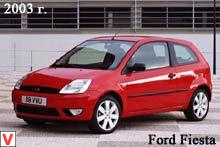
A distinctive feature of the Ford ST series was the central red strip, which first appeared exactly on Fiesta ST. In addition, this modification can be distinguished by the increased grille, low bumpers, reduced ground clearance, rear spoiler and 17-inch alloy wheels. In 2004, the Fiesta Van, a new van based on the Fiesta, was launched at the Ford plant in Germany. In 2008, the world premiere of the new generation Ford Fiesta took place in Geneva. The appearance of the production model was preceded by a concept called Verve. The car received an aggressive, athletic and moderately futuristic design. Corporate Ford kinetic style is manifested in each body panel.
Huge headlights with a complex geometry and rear optics of fancy shape are striking the eye. V-shaped swift silhouette fell into the topic. After all, the Ford Fiesta has always been famous for its catchy character. As for the model palette, the 2009 Fiesta is produced as a three-door and five-door hatchback. The new Fiesta is attractive not only externally but also internally, or rather technically. The creators have tried to equip a compact car with all the achievements of modern technology. The interior will not leave anyone indifferent.
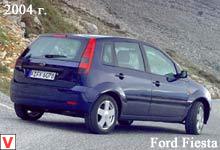
Access to the salon gives a contactless key, the engine starts with a button. There is enough space for four adults. Even in the Ford Fiesta appeared Bluetooth interface, USB-port, adjustable steering wheel on the departure and airbag for the driver's knees. And in the expensive versions there will also be a shield Ford Convers +, successfully tested on the Mondeo and S-Max.
The palette of power units is represented by five options - four petrol and one diesel. The base petrol is a 1.25-liter 60-hp, followed by a 1.25-liter 82-hp, 1.4-liter 96-hp. The most powerful version is equipped with a 1.6 liter Duratec engine producing 120 hp. Among its features is a system of variable valve timing at the inlet. The only diesel unit is represented by a 1.6-liter 90-horsepower. Gearboxes are 5-speed “mechanics” and 4-range “automatic”.
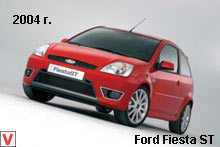
The suspension scheme will not change fundamentally: McPherson strut front and torsion beam behind. The car is produced in factories in Cologne, Germany and Valencia, Spain. The 2009 Fiesta is a new phase in Ford’s global development program. Until 2010, the company plans to bring the model to the borders of Asia, South Africa, Australia and the USA. At the Paris Motor Show 2012, the official presentation of the Ford Fiesta restyled hatchback was held. The updated car received a trapezoidal grille in the style of Ford Focus and Fusion models. Daytime running lights have become LED.
But the main thing in this update is not changed appearance, and a revised range of engines. The restyled Fiesta will go on sale in the European market with the following gasoline engines: aspirated 1.0 (80 hp), 1.25 (60 and 82), 1.6 (105), and also with the EcoBoost 1.0 (100 or 125) turbo engine. In the family of turbodiesel units will be 1.5 TDCi (75 forces) and 1.6 TDCi (95). Thus, on the Fiesta, European specifications will no longer be equipped with 1.4 (96 hp), 1.6 (120 and 134) and 1.4 TDCi (70) engines. The “charged” version of the Fiesta ST, which is now equipped with a 1.6-liter turbo engine with 182 horsepower, has also been updated.
It is not yet known what engines will consist of the holder of Russian modifications. The start / stop system will be available with versions 1.0 and 1.6 TDCi Econetic. At restyled Fiesta install mechanical and preselective robotic gearboxes. The model received the Sync multimedia system, which, in addition to music and information, includes an emergency option that directly connects the driver, passengers with operators, local emergency services in the event of an accident, the MyKey security system, which allows you to block access to certain vehicle functions (speed limit, audio sound, etc.).
